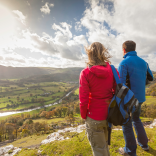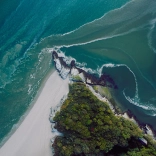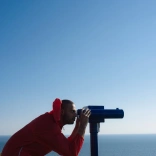Our voice is an important part of our brand. It shows the world who we are, through how we speak and write. And, it’s usually the first part of our brand people will come across – so it’s important we get it right and make a good first impression. Our voice covers the words we use, the words we avoid, the way we construct our sentences. It comes from our personality as a brand. And our personality comes from our values:
Authentic
Wales is the real deal. Open, honest – our country is built on the foundations of a proud history and heritage, and shaped by a bold and beautiful landscape. We care deeply for community, culture and cynefin (one’s square mile) and want to lead the world in protecting them. Because these resources power us: green growth, global creative exports, adventure attractions, quality local produce. Our authenticity is the key to our future.
Creative
Creativity is at the heart of our nation. Our rich and enduring culture is thriving: in music, literature, art, film, television and theatre. But it’s much more than that. Everywhere you look in Wales, there are bright new ideas being put into action. It’s happening in design studios and quarry mines, factories and laboratories across the country. There’s an entrepreneurial spirit in the air. We’re not just dreaming big, we’re making it happen.
Alive
A new Wales is emerging. Inspired by our past but looking towards the future with responsibility and creativity. Our landscapes are alive with nature and adventure. Our culture is alive with imagination. Our communities are alive with opportunity and real innovation. A new generation is investing in a bright and sustainable future, driven by talent and skill. Full of life.
Where something isn’t specified here, please follow the Guardian style guide. Where something isn’t explicitly covered, follow Guardian usage. For Government terms and departments refer to The Government Digital Service (GDS) style guide.
This is a live style guide and we are constantly adding to it and revising current sections. If you have suggestions for things to include, please get in touch with the content editorial team.
Please also refer to the content strategy guidance, individual Wales.com tone of voice and target audience guidance and Visit Wales tone of voice and target audience guidance, and the article visual style guide to see how text and media components display on a published article page.
If an acronym is not well known, always spell it out the first time. If you are using it multiple times, let people know what it is the first time then show it in brackets: for example, WTM (World Travel Market). Then you can use the acronym in your copy.
Try and avoid using e.g. – write out “for example” where possible.
SUP should be written in full as stand up paddleboarding. All lowercase, and no hyphen. Add (SUP) in brackets afterwards so that both terms can be found by search.
BAME should be written as the full phrase ‘Black, Asian and Minority Ethnic’. For any subsequent references within the same communication ‘ethnic minority’ or ‘ethnic minority communities/staff' should then be used.
Acronyms like pdf are always lowercase.
Do not use full stops in acronyms: UEFA, NHS.
Cadw is not an acronym, so should always be written as Cadw, not CADW.
We have made every effort to make the Wales.com and VisitWales.com websites easy to use and accessible to everyone. We have aimed to make the sites adhere to the WCAG Version 2 (AA) guidelines. See the specific Accessibility Statement for each site linked to from the site footer for more details.
Writing for accessibility goes beyond making everything on the page available as text. It also affects the way you organize content. Break text into short paragraphs to make it easy to scan. Use subheadings and bullet points to guide readers through the text.
Links
Always use meaningful links that help tell the user what the content linked to is - use the name of the business, website, or describe the content in words. Avoid using urls in their full form, or using words like “Click here”, “Click for more information” or “Read this.” Write the sentence as you normally would and link relevant keywords. Never use url paths such as https://www.sitename.com/ as this is hard for both users and screenreaders to read.
Don’t include preceding articles (a, an, the, our) when you link text. For example:
- Yes: Read the editorial content style guide for details.
- No: Read the editorial content style guide for details.
If a link comes at the end of a sentence or before a comma, don’t link the punctuation mark.
Social media links should contain the full name of the account and platform within the link, so for example:
- Not "See the Visit Wales Facebook page for details"
- But "See the Visit Wales Facebook page for details"
For usage conventions see the links guidance in the Punctuation and content elements section below.
Alt tags / alt text
Alt text is a way to label images. It's especially important for people who can’t see the images on our website and rely on screen readers to understand our content. Alt text should describe the image in a brief sentence or two. People who don’t see the image should come away with the same information as if they had. You don’t need to say ‘image of…’ at the start of your description.
A good explanation of how to write alt text is available here: How to write text descriptions (alt text) in BBC News articles (BBC).
Contrast
If you're creating images with text over the top (e.g. image slideshows for social channels) make sure there’s enough contrast on the text so it’s easy to read. Use a contrast checker to make sure your text is readable.
As a rule, never use ampersands in body text, unless it is the part of a company name (P&O, Marks & Spencer), or in the title of a book or television programme (Gavin & Stacey).
Also ampersands can be used in the context of talking about bed and breakfasts (bnbs / b&bs), as this is a fairly standard industry term. But try to avoid using it if you can.
Wales, in the possessive, is always Wales’, not Wales’s. Like Wales’ beautiful coasts, Wales’ epic mountains.
While it would be preferable to try and rephrase the sentence to switch the possessive around before it, where required, this applies to use of Visit Wales' when talking about the brand and website too.
St Davids, Pembrokeshire – Note the apostrophe difference between St Davids the location and St Davids Cathedral versus St David’s Day, or St David’s Hotel and Spa in Cardiff. If you are talking about something that belongs to the saint, remember it’s possessive – so St David’s flagon of ale.
St Donats the arts centre has no apostrophe, but St Donat’s Castle does have an apostrophe.
There is no apostrophe in St Brides or St Brides Bay.
Language is a powerful tool. And we have two. While we have separate all Welsh language sites for Visit Wales (Croeso.cymru), our language is part of our history and future. It is a deeply rooted part of our story and culture that makes us stand out – so be proud of it, and don’t be afraid to use it on our English language sites. It’s a great way of sparking curiosity, so weave in the odd word of Cymraeg into your prose, if it feels natural.
Some articles may be a need to written differently for a Welsh language audience - it wouldn't be appropriate to translate an English article about the Welsh language, or the meanings of Welsh place-names into Welsh for a Welsh user.
When using words of Welsh (or any other language) within English body copy, italicise the word/s to make it easier for people to identify them as a different language. As Welsh words are often so poetic and descriptive, consider adding a literal translation to give more context and deeper understanding to the reader.
To cwtsh or to cwtch? That is the question
You may see the word cwtsh (our word for something that falls between a cuddle and a snuggle) also written as cwtch. Strictly speaking, cwtsh is the Welsh spelling, so that's what we try to stick to.
See the Place-names section below for specific guidance on using Welsh place-names.
The acronym ‘BAME’ should not be used, instead it should be written as the full phrase ‘Black, Asian and Minority Ethnic’. For any subsequent references within the same communication ‘ethnic minority’ or ‘ethnic minority communities/staff' should then used.
Unless including a named thing, e.g. Wales Coast Path, use sentence case, not title case, for all titles and headings.
Upper case:
- organisations (Welsh Government, Visit Wales);
- books, films, works of art. The titles of books/films also need to be italicised (I really enjoyed reading The Mabinogion, I also loved Under Milk Wood, and Road Rage is my favourite song); however we DO NOT italicise the titles of magazines (National Geographic, Conde Nast Traveller);
- jobs: if talking generally, jobs are lower case (chief executive, prime minister). Cap up titles, e.g. Prime Minister Dylan Thomas (but the prime minister on subsequent mentions);
- artistic and cultural names of institutions get initial caps (National Museum of Wales, then just museum on subsequent mentions);
- places and directions: if we're talking about a specific region, it is capitalised (South Wales, North Wales, the East, the West - but lowercase if talking generally about the north of Wales, or west of Wales, or the south of Wales);
- castles and monuments: Raglan Castle, but the castle at Raglan.
- National Park and Bannau Brycheiniog (Brecon Beacons) National Park
Lower case:
- airport (Cardiff Airport, but the airport at Cardiff);
- geographical features (a river, a peninsula, unless it forms part of the name of the place – like the Llŷn Peninsula);
- places and directions (see also above): if we're talking generally about directions, it's lowercase - I live in the north of Cardiff, I'm from the east of Swansea, I'm from the north part of Wales. If it's a specific region (the North, the South, West Wales etc - that is capitalised);
- pdf not PDF;
- seasons (spring, summer, autumn, winter).
(SEE ALSO: NUMBERS)
We use imperial and metric systems when talking about distances. The conventions are as follows:
We use miles rather than kilometres, but where possible add in the km conversion in brackets after miles to make it easier for visitors to understand the distance. For example: 50 miles (80 km).
We use metres for shorter distances.
Make sure to write out miles / metres / millions as full words to avoid confusion. Other distances of measurement can be abbreviated as long as it's clear what they mean (for example - km for kilometres).
To support the sense of place and cultural experience of Wales we have a bespoke typeface collection that takes cues from the Welsh typographical heritage. The font acts as a unifying cornerstone of the visual brand identity, representing Wales to the world in an authentic and creative way.
We’ve built in a series of glyphs and diagraphs that support sense of place and character as is required.
- Cymru / Wales Sans is typically used as a headline font
- Cymru / Wales Serif is used across body copy
Our fonts have been developed in conjunction with accessibility agencies to review and adjust the font where required.
The Cymru font is used across all titles on the Croeso.Cymru site. On our other language sites it should be applied to Welsh words in H2 headings. It should not be used for H3 headings on these sites, or in body copy on any site.
It's important to write for and about other people in a way that’s compassionate, inclusive, and respectful.
- Don’t reference age or disability unless it’s relevant to what you’re writing.
- Avoid gendered language and use the singular “they.”
- When writing about a person, use their preferred pronouns; if you don’t know those, just use their name.
For further detail see the Conscious Style Guide.
Also see the further guidance below on the Social model of disability.
In narrative documents (not including tables or formatted numerical documents) spell out from one to nine; then it’s numerals from 10 to 999,999, EXCEPT for distances, weights, measures and dates.
Therefore: three years old, four elephants; under-fives; two dumplings, BUT 3 miles, 1km, 8kg, 9sq m.
However, write 8 to 16 years old, not eight to 16.
Ordinal numbers follow the same pattern, so first to ninth, secondly, then 10th etc. (this does not apply to dates).
If the sentence starts with a number, always write it out in full: Seventy-six trombones in the big parade.
Million and billion are rendered as words: four million unemployed people; 8.7 million units; £1.5 billion.
Hundreds of thousands, tens of millions.
Per cent: in web copy this should always be per cent in body text, never %. In print, % is okay to use as long as it remains consistent throughout the publication (no mixing and matching).
Dates
As a general rule, try to avoid the use of dates and times, to keep content as evergreen as possible. Where required follow Guardian style guidance;
Our style on dates is: 10 September 2017 (day month year; no commas). Do not use “th”, “st” in superscript.
AD goes before the date (AD64), BC goes after (300BC); both go after the century: second century AD, fourth century BC, or 11th century AD.
Distance
Use miles rather than kilometres, but where possible add in the km conversion in brackets after miles to make it easier for visitors to understand the distance. For example: 50 miles (80 km).
Use metres for shorter distances.
Make sure to write out miles / metres / millions as full words to avoid confusion. Other distances of measurement can be abbreviated as long as it's clear what they mean (for example - km for kilometres).
Distance - area measurements
We use imperial measures first and metric after in brackets where possible. For area measurements, square miles (sq miles) or square kilometres (sq km) are generally easier to understand than acres or hectares so we use those where possible. Make sure to write the area measurements out in full as above rather than using superscript characters.
Abbreviations are okay as long as they can be easily understood.
For example:
The size of Wales! Wales is about 8,194 sq miles (21,224 sq km) - or 2,122,400 hectares.
Times and timescale
Use of times depends on context.
1am, 6.30pm, etc; 10 o’clock last night but 10pm yesterday; half past two, a quarter to three, 10 to 11, etc; 2hr 5min 6sec, etc; for 24-hour clock, 00.47, 23.59; noon, midnight (not 12 noon, 12 midnight or 12am, 12pm).
Put dates in brackets when there might be ambiguity.
Years
Abbreviate decades when referring to those within the past 100 years.
- the 00s
- the 90s
When referring to decades more than 100 years ago, be more specific:
- the 1900s
- the 1890s
To raise the profile of Welsh place-names should be used where appropriate in the body copy of editorial articles on the Visit Wales consumer site.
However, to ensure our content is optimised for search English place-names should be used in editorial titles, in structured page headings (H1, H2 and H3's), and in meta page titles and meta descriptions which have limited character counts.
When using Welsh place-names for the first time in body copy, always follow with the English place-name in brackets. Further use of the Welsh place-name on that page does not then need to have the English name in brackets again, otherwise the page will be too long and it will interrupt the flow of the piece. Where there’s only one name for a place (English or Welsh), just use the one: e.g. Cwmtydu. Welsh place-names should not be italicised.
Weave in the occasional use of Cymru rather than Wales in body copy, to highlight how the terms are interchangeable and both commonly used when referring to our country as a whole. Wales should not be included, either in brackets or without, after the use of Cymru, unless referring to the Cymru Wales brand which uses both names without brackets. Where used, Cymru should not be italicised.
Welsh place-names must ALWAYS be checked for accuracy.
A list of Welsh place names is available on the Welsh Language Commissioner website. Place-names are listed in alphabetical order and can be searched for or filtered by name, local authority or type.
If you cannot find the name you or searching for, email your query to post@cyg-wlc.cymru.
Other additional research may also be useful, e.g. checking with different tourism sites like Discover Ceredigion, finding the name on the English site, then checking it on the Welsh version of their site.
Wikipedia will usually have the Welsh place names in brackets after the English name in an article about a particular place, but not always. Visit the Welsh language Wicipedia article on the same place to double check what is acceptable in Welsh (but Wikipedia isn’t always accurate!).
The Welsh Place-Name Society are also a good resource for queries or checking. Contact them via the contact page on the website, or via their Facebook page.
Specific examples:
Aberystwyth Ceredigion should be used when referring to the UNESCO City of Literature or UNESCO Creative Cities Network designation. This form should be used in headlines, standfirsts and on first mention. Subsequent references may use Aberystwyth, provided the UNESCO designation has already been clearly attributed to Aberystwyth Ceredigion..
Areas of Outstanding Natural Beauty (AONBs) / National Landscapes - As of November 2024, Wye Valley, Gower, Clwydian Range and Dee Valley have formally adopted the new brand National Landscapes. These should be referred to as National Landscapes (formerly AONBs) in copy on the website as users will continue to search using the established ANOB term.
Anglesey will also adopt the new brand but have yet to confirm a date for this so should remain as being referred to as an Area of Outstanding Natural Beauty (AONB), until a date for the change is announced.
NOTE: Llŷn AONB has decided not to adopt the National Landscapes brand and should therefore continue to be referred to as an Area of Outstanding Natural Beauty (AONB).
Anglesey when using English is Anglesey, even though the constituency is always called Ynys Môn (in either language).
Bannau Brycheiniog (Brecon Beacons) to be used when referring to the area.
Cader Idris to be used rather than Cadair Idris, in line with NPA - Minffordd Path | Walks and Routes Snowdonia National Park (gov.wales) and Visit Snowdonia - Pony Path, Tŷ Nant | Visit Snowdonia
Gower is either Gower or the Gower Peninsula. NEVER the Gower. Same for Llŷn – either Llŷn, or the Llŷn Peninsula. If you go to Gower you are 'on Gower', not 'in Gower', or 'on the Gower'.
Llyn Tegid not ‘Bala Lake’.
New Quay, (two words), in Ceredigion – not Newquay, which is in Cornwall.
Rhossili, with double s is the English spelling. The Welsh spelling is with a single s - Rhosili.
Shell Island is the name of the campsite not the location itself, though it is sometimes known and referred to as this. The location should always be referred to with the Welsh name Mochras. This can then be follwed by (also known as Shell Island) in brackets.
There is no apostrophe in St Brides or St Brides Bay.
St Davids, Pembrokeshire – Note the apostrophe difference between St Davids the location and St Davids Cathedral versus St David’s Day, or St David’s Hotel and Spa in Cardiff. If you are talking about something that belongs to the saint, remember it’s possessive – so St David’s flagon of ale.
St Donats the arts centre has no apostrophe, but St Donat’s Castle does have an apostrophe.
Wales, in the possessive, is always Wales’, not Wales’s. Like Wales’ beautiful coasts, Wales’ epic mountains.
Ynys Llanddwyn not Llanddwyn Island.
Yr Wyddfa (Snowdon) and Eryri (Snowdonia) to be used when referring to these locations.
South Wales Valleys or the South Wales Valleys - never just The Valleys.
regionsThe regions of Wales - South Wales, Mid Wales, North Wales and West Wales should always be capitalised and should not be hyphenated.
When talking about specific regions, these are capitalised (North Wales, South Wales, the East, the West).
When talking about general directions, these are always lowercase (driving north on The Cambrian Way, to the south of Wales, I'm from the north of Wales, the northern part of South Wales). Ordinal directions are lowercase, written out in full and joined without a hyphen; northeast, southeast, southwest and northwest. Not North East, north-east or NE. E.g. To the southwest is Fforest Fawr.
For the purposes of our websites, the four regions of Wales are split into tourism marketing areas as follows:
North Wales includes -
- Llandudno and Colwyn Bay
- North East Wales
- Snowdonia Mountains and Coast
- The Isle of Anglesey
Mid Wales includes -
- Ceredigion/Cardigan Bay
- Mid Wales and Bannau Brycheiniog (Brecon Beacons)
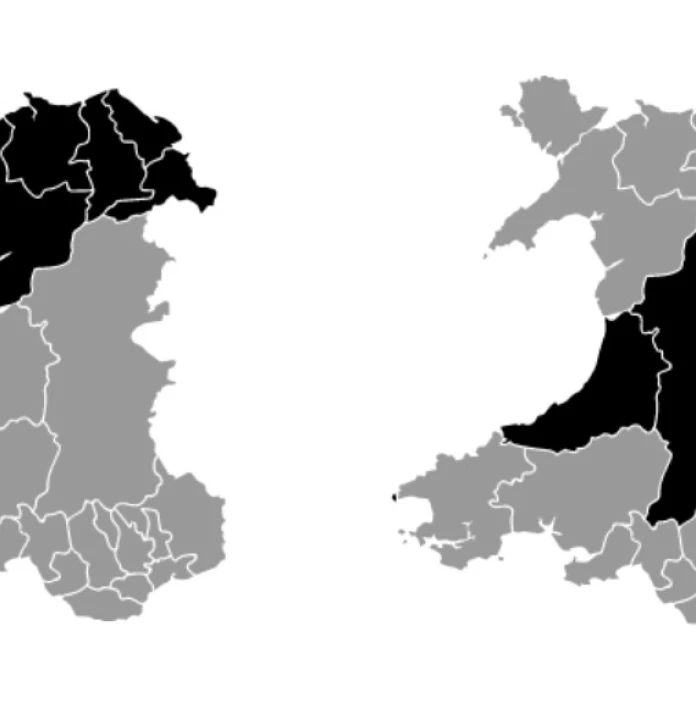
West Wales includes -
- Carmarthenshire
- Pembrokeshire
- Swansea Bay, Mumbles, Gower and Neath Port Talbot
South Wales includes
- Cardiff (capital of Wales)
- South Wales Valleys
- Wye Valley and Vale of Usk
- Glamorgan Heritage Coast
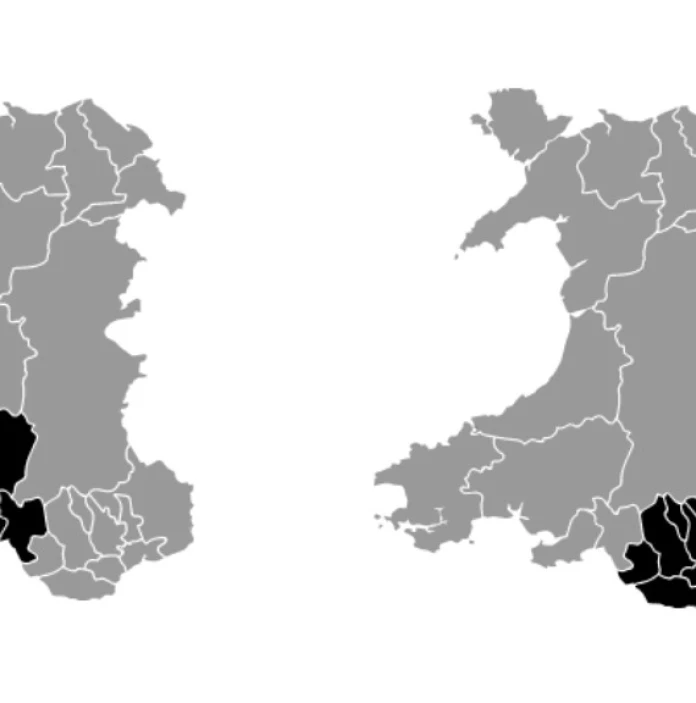
Apostrophes
Plurals DO NOT TAKE apostrophes: humans, sisters, oranges, horses. Same goes for plurals of acronyms: MCs, DJs, MP3s, CDs.
Possessive: if something belongs to someone, then an apostrophe indicates this (e.g. Gwenno’s book).
If a name or word ends with an s, it would usually take an apostrophe and a second s, but be guided by sound and pronunciation and use the plural apostrophe where it sounds better (e.g. Hedges’ rather than Hedges’s)
Wales, in the possessive, is always Wales’, not Wales’s. Like Wales’ beautiful coasts, Wales’ epic mountains.
Bold and italics
Use bold to highlight the name of a person who is the subject of an article in the intro paragraph.
Do not italicise the article intro paragraph.
Other than the above we don’t use bold in normal text on our websites.
Where they improve clarity and help to make the point, we use italics to emphasise words within a sentence, but very sparingly. One example in this VisitWales article about unusual places to stay:
"Now for some really different options. At the award-winning Willows campsite on North Wales’ Llŷn Peninsula, you can stay in a fully-insulated Hobbit Tent that resembles a circular wooden tube. Family-run Penhein Glamping in the beautiful Wye Valley offers Persian 'alachighs' – tents with high domed ceilings, comfy beds (proper ones) and wood-burning stoves to keep you cosy."
Bullet points
When using bullet points, you should:
- end the sentence introducing the list with a colon;
- always start bullet points with lower case letters;
- use a semi-colon at the end of each bullet point;
- place a full stop at the end of the final bullet point.
Headings
Unless including a named thing, e.g. Wales Coast Path, use sentence case for all titles including:
- Editorial titles
- H1
- H2 / H3 (in-page titles)
- Meta tag page titles
Frontload your keywords and try to keep headlines short (less than 75 characters if possible).
Okay: Coming soon to Cardiff: UEFA Champions League
Better: UEFA Champions League coming soon to Cardiff
The Cymru font is used across all titles on the Croeso.Cymru site. On our other language sites it should be applied to Welsh words in H2 headings. It should not be used for H3 headings on these sites, or in body copy.
Hyphens
Dog-friendly is always hyphenated.
Pet-friendly is always hyphenated.
Award-winning is always hyphenated. Multi award-winning, would be better written as multiple award-winning instead, as multi is not such a well known word for international English speakers.
Stand up paddleboarding is never hyphenated and should be written in full, rather than as SUP, but add (SUP) in brackets afterwards so that both terms can be found by search.
Links
See 'Accessibility' section above for best practice guidance on adding in-line links to body copy.
Use internal links to same site pages where possible, including linking to the VW product database. Where providers do not have an internal product page, link externally to the website of the provider.
For Wales.com content, where the site is much smaller include links to the external 'sister sites' - Visit Wales, TradeandInvest.Wales, Study in Wales, in order to ensure an onward journey for users.
Use the following conventions for in-line links:
- Tourism Product Database - all product links should point to product database pages (/twg-product/xxxxxx) - this applies to Visit Wales consumer, Travel Trade and Meet in Wales B2B sites. Links to the product database should not be used on the Croeso.Cymru site in copy but product strips can be used to link to Welsh language database pages.
- Internal - link between pages by using the node (/node/xxxxxx)
- External - link to an external site using the full url (https://xxx) and select 'Open in new window/tab' from the 'advanced' options.
Quotes
When quoting, use single quotation marks at the start and end. Place full points and commas inside the quotes for a complete quoted sentence; otherwise the point comes outside, e.g. Cerys said: ‘Your style guide needs updating’.
Use double quotation marks for words that aren’t actually quotations, for example: These are the people who put the “style” in style guide.
In headlines and standfirsts, captions and display quotes all take single quote marks.
Try to avoid parentheses in direct quotes as much as possible, where necessary, use square brackets.
If you use the 'pull quote' article component to highlight the quote within the article, use the guidance in the standard article components section of the visual style guide.
Spacing
In body copy, house style is to use one space after a full stop, not two.
No full stops in landmarks or titles (Dr Jones, not Dr. Jones – St Dogmaels, not St. Dogmaels).
Stars or *?
Many leisure and tourism businesses (like hotels or restaurants) are graded, usually with a 'star' system.
When talking about these places, our convention is to write the number and hyphenate with the word 'star' or 'stars', rather than using the symbol.
Always: The hotel has a five-star restaurant.
Never: The hotel has a 5* restaurant.
Whiskey
Welsh whisky, made in Wales at distilleries such as Penderyn is spelt without the e.
Always: whisky
Never: whiskey
At Visit Wales we use the social model of disability in language and practice.
The historic approach to disability in the UK has been based on the Medical Model of Disability (in which a person’s impairment is seen to be the thing which disables them). The Social Model of Disability distinguishes between ‘impairment’ and ‘disability’. It recognises that people with impairments are disabled by barriers that commonly exist in society.
Put simply, the Social Model of Disability tells us that individuals may have an impairment or difference, but it is society that disables them by the obstacles we put in their way. For example:
- A person with a mobility impairment who uses a wheelchair is disabled by a building which doesn’t include lifts, ramps or accessible toilets
Associated terminology
Impairment is the thing about a person which is different. Impairment and disability do not mean the same thing.
Disability is the things which society, the environment, or policy do to a person with an impairment which disadvantages them.
Use invisible impairment rather than hidden disability.
Use non-disabled rather than able-bodied.
Use additional learning needs or access requirements (depending on context), rather than special needs.
Do not use vulnerable to refer to people with an impairment ('disabled people'). Anyone can become vulnerable for different reasons at different times in their lives. People with an impairment are often described as vulnerable and this is often wrong and does nothing to promote equality.
Use of Medical Model terminology
Terms from the Medical Model of Disability may also be found within our website. We use these to help people find the content they are looking for when they search for certain terms. For example, we may still include phrases like ‘holidays for disabled people’ within an article or its metadata because that is what people are looking for when they use search engines.
More information
You can find further information and advice on Disability Wales' Social Model of Disability web page.
You can also watch the 'Let's Raise the Roof' animation which illustrates The Social Model of Disability.
The Wales Way is a family of three routes, distinct but complementary, that grant access to the best of our nation – The Coastal Way, The Cambrian Way and The North Wales Way.
All should be capitalised when used in copy, including the The.
VisitWales.com is a showcase for Wales to grow our economy and promote our communities. The emphasis of the site is not to promote any individual business but on exploring Wales and its regions.
When producing content we aim for geographical spread across our content to showcase the best of what Wales has to offer at a broad level. Where lists are concerned we must cover a good regional spread and present them as must do, ten great or don't miss rather than top ten or five of the best. Where articles are authored by external contributors we respect editorial choice and so lists in this instance may be personal favourites backed by experience.
Where products are concerned, in order to ensure quality and safety, only businesses that have the necessary accreditation, grading or industry standards should be included in our content. The first link to the product in editorial content should point to the VW product listing rather than the providers external website. Deeper links to the providers external website may then be added later in the article where there is a requirement to provide the user with further detailed information than is provided on the Visit Wales product listing page.
- Accommodation must be accredited with Visit Wales or the AA star quality grading.
- Activities must be accredited through Wales Adventure Tourism Organisation (WATO)
- Attractions - preference should be given to those accredited as part of the Visitor Attraction Quality Scheme (VAQAS). Other attractions may be included if they have been checked for a quality visitor experience, either by personal recommendation or via review sites.
- Events must meet our Events Criteria.
Food and Drink eateries must have a Food Standards Agency Food Hygiene rating of 4 or 5. Our approach is to promote anywhere that is considered strong for tourism marketing purposes, but we should make a point of featuring places with a Welsh food and drink offering whenever we can.
How to check:
All accommodation, activities, attractions and events listed on the Visit Wales search database meet the required criteria, so all products should be checked using the on-site search function before being included.
The hygiene rating for food businesses can be found using the search function on the Food Standards Agency website.
The Food and Drink Wales team can provide help and advice regarding businesses producing and serving fantastic Welsh produce.


